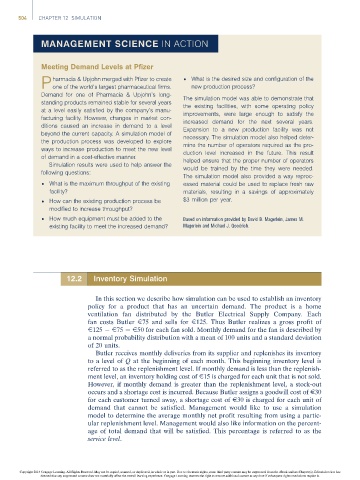Page 524 -
P. 524
504 CHAPTER 12 SIMULATION
MANAGEMENT SCIENCE IN ACTION
Meeting Demand Levels at Pfizer
harmacia & Upjohn merged with Pfizer to create • What is the desired size and configuration of the
P one of the world’s largest pharmaceutical firms. new production process?
Demand for one of Pharmacia & Upjohn’s long-
The simulation model was able to demonstrate that
standing products remained stable for several years
the existing facilities, with some operating policy
at a level easily satisfied by the company’s manu-
improvements, were large enough to satisfy the
facturing facility. However, changes in market con-
increased demand for the next several years.
ditions caused an increase in demand to a level
Expansion to a new production facility was not
beyond the current capacity. A simulation model of
necessary. The simulation model also helped deter-
the production process was developed to explore
mine the number of operators required as the pro-
ways to increase production to meet the new level
duction level increased in the future. This result
of demand in a cost-effective manner.
helped ensure that the proper number of operators
Simulation results were used to help answer the
would be trained by the time they were needed.
following questions:
The simulation model also provided a way reproc-
• What is the maximum throughput of the existing essed material could be used to replace fresh raw
facility? materials, resulting in a savings of approximately
• How can the existing production process be $3 million per year.
modified to increase throughput?
• How much equipment must be added to the Based on information provided by David B. Magerlein, James M.
existing facility to meet the increased demand? Magerlein and Michael J. Goodrich.
12.2 Inventory Simulation
In this section we describe how simulation can be used to establish an inventory
policy for a product that has an uncertain demand. The product is a home
ventilation fan distributed by the Butler Electrical Supply Company. Each
fan costs Butler E75 and sells for E125. Thus Butler realizes a gross profit of
E125 E75 ¼ E50 for each fan sold. Monthly demand for the fan is described by
a normal probability distribution with a mean of 100 units and a standard deviation
of 20 units.
Butler receives monthly deliveries from its supplier and replenishes its inventory
to a level of Q at the beginning of each month. This beginning inventory level is
referred to as the replenishment level. If monthly demand is less than the replenish-
ment level, an inventory holding cost of E15 is charged for each unit that is not sold.
However, if monthly demand is greater than the replenishment level, a stock-out
occurs and a shortage cost is incurred. Because Butler assigns a goodwill cost of E30
for each customer turned away, a shortage cost of E30 is charged for each unit of
demand that cannot be satisfied. Management would like to use a simulation
model to determine the average monthly net profit resulting from using a partic-
ular replenishment level. Management would also like information on the percent-
age of total demand that will be satisfied. This percentage is referred to as the
service level.
Copyright 2014 Cengage Learning. All Rights Reserved. May not be copied, scanned, or duplicated, in whole or in part. Due to electronic rights, some third party content may be suppressed from the eBook and/or eChapter(s). Editorial review has
deemed that any suppressed content does not materially affect the overall learning experience. Cengage Learning reserves the right to remove additional content at any time if subsequent rights restrictions require it.

